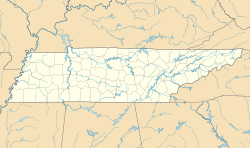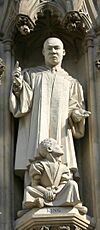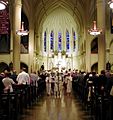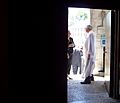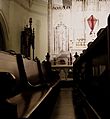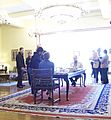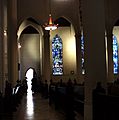St. Mary's Episcopal Cathedral (Memphis, Tennessee) facts for kids
Quick facts for kids St. Mary's Episcopal Cathedral |
|
|---|---|
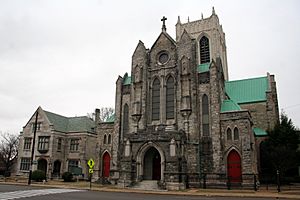
Diocesan House, Cathedral, Sisters' Chapel
|
|
| 35°8′48.2″N 90°2′12.56″W / 35.146722°N 90.0368222°W | |
| Location | 700 Poplar Avenue Memphis, Tennessee |
| Country | United States |
| Denomination | Episcopal |
| History | |
| Status | Cathedral |
| Founded | 1858 (parish) |
| Consecrated | 1871 |
| Architecture | |
| Functional status | Active |
| Architect(s) | William Halsey Wood (original plans), L. M. Weathers, and Bayard Snowden Cairns |
| Style | Late Gothic Revival (Early English period) |
| Completed | 1858 (original) 1888 (chapel) 1898 (crypt) 1907 (west front and nave) 1926 (tower, transepts, chancel) |
| Administration | |
| Diocese | West Tennessee |
| Province | IV (Southeast) |
St. Mary's Episcopal Cathedral is a beautiful church located near downtown Memphis, Tennessee. It serves as the main church for the Episcopal Diocese of West Tennessee. A cathedral is like the "home church" for the bishop, who is a leader in the Episcopal Church.
Contents
History of St. Mary's Cathedral
How St. Mary's Began
St. Mary's started as a small mission chapel in North Memphis. It was created by a group of ladies from Calvary Church. This was the first Episcopal church in Memphis.
The first service at St. Mary's was held on Thanksgiving Day, November 26, 1857. It was led by Charles Quintard. He later became an important bishop for the Diocese of Tennessee.
A newspaper article from that time described the new church. It said that St. Mary's would have "free seats." This was special because other churches often charged money for pews. This meant that more people, even those without a lot of money, could attend services.
St. Mary's officially became a parish church on May 13, 1858. This was done by Bishop James Hervey Otey, the first Bishop of Tennessee.
First Episcopal Cathedral in the South
Just thirteen years after it started, St. Mary's became the very first Episcopal cathedral in the southern United States. This official change happened on January 1, 1871.
At that time, not many Episcopal churches in America were called cathedrals. Cathedrals were more common in England. But as the church grew, more American dioceses started having cathedrals. St. Mary's was a leader in this trend.
Helping During the 1878 Yellow Fever Epidemic
Memphis faced many outbreaks of yellow fever in the 1800s. This was a serious illness spread by mosquitoes. The worst outbreak happened in 1878. Over 5,000 people in Memphis died, and the city lost many residents.
A few years before, a group of Episcopal nuns, called the Sisters of St. Mary, came to Memphis. Bishop Quintard invited them to run the St. Mary's School for Girls. This school is now known as St. Mary's Episcopal School.
When the 1878 epidemic hit, many brave people stayed behind to help the sick. This included priests, nuns, doctors, and even a local business owner named Annie Cook. They knew it was very risky, but they wanted to help.
St. Mary's Cathedral became a relief center during this time. The Sisters of St. Mary and Episcopal priests worked there. Sadly, the leader of the nuns, Sister Constance, and three other nuns, along with two priests, died from yellow fever at the cathedral.
These brave people are remembered as "Constance and Her Companions." They are also called the "Martyrs of Memphis." The Episcopal Church honors them every year on September 9.
Here are the names of Constance and Her Companions:
- Sister Constance (Caroline Louise Darling), the leader of the nuns.
- Sister Thecla, who taught music and languages.
- Sister Ruth, a nurse.
- Sister Frances, who cared for an orphanage.
- The Rev. Charles Carroll Parsons, a priest from Memphis.
- The Rev. Louis S. Schuyler, a new assistant priest.
The Very Rev. George Harris, who was the dean of the cathedral, survived the yellow fever. Sister Hughetta also survived and continued the nuns' work in Tennessee.
The "New" Cathedral Building
The current beautiful Gothic Revival style building of St. Mary's Cathedral was built over many years. Construction started in 1898 and finished in 1926. The cathedral was then also called "Gailor Memorial." This was to honor Bishop Thomas Frank Gailor, who was an important leader in the Episcopal Church.
Responding to Martin Luther King, Jr.'s Assassination
St. Mary's Cathedral played a role in another important historical event. This was the assassination of Martin Luther King, Jr. in 1968. King was killed just two miles from the church.
The day after King's death, many religious leaders from Memphis met at the cathedral. The dean of the cathedral, William Dimmick, decided to act. He took the cathedral's cross and led the ministers in a march to City Hall. They wanted to ask the mayor to help end a labor strike. King had been in Memphis to support sanitation workers who were protesting for better conditions and pay.
Because of Dean Dimmick's actions for racial unity, almost half of the cathedral's members left the church. They disagreed with his public stand.
Like Constance and her companions, Martin Luther King, Jr. is also honored by the Episcopal Church. His feast day is April 4. He is also remembered with a statue at Westminster Abbey in London, along with other important figures.
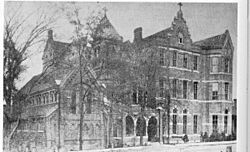
Sisters' Chapel and St. Mary's School, 1900
|
|
| Monastery information | |
|---|---|
| Other names | St. Mary's School for Girls, Church Home |
| Order | Community of St. Mary (Episcopal) founded in New York, NY, 1865 as the "Sisterhood of St. Mary" |
| Established | 1873, at request of Bishop Charles Quintard |
| Disestablished | 1910, when the sisters formally moved to St. Mary's on the Mountain Convent, Sewanee, Tennessee |
| Mother house | Mount St. Gabriel Convent, Peerskill, New York |
| Diocese | Episcopal Diocese of Tennessee |
| People | |
| Founder(s) | Sister Constance, superior at Memphis; Sister Harriet, founder and mother superior, Sisterhood of St. Mary |
| Important associated figures | Constance and her Companions (yellow fever martyrs listed in the Episcopal Calendar of Saints) |
| Site | |
| Location | On the close of St. Mary's Cathedral, Memphis, Tennessee |
| Visible remains | Sisters' Chapel (on the cathedral close), original New York 1865 Sisters' altar (in the cathedral nave), group grave marker of yellow fever martyrs at Elmwood Cemetery |
| Public access | Today, a number of St. Mary's Cathedral members (men and women, lay and ordained) are also associates of the Community of St. Mary: people who commit themselves to follow a personal "rule of life". |
The Diocese of West Tennessee
For a long time, the Episcopal Diocese of Tennessee covered the entire state. But in 1982, it was divided into three parts. This was based on the three main regions of Tennessee.
The Episcopal Diocese of West Tennessee was created in 1982. St. Mary's Cathedral became its main church. Later, in 1985, the Diocese of Tennessee was split again. This created the Episcopal Diocese of East Tennessee.
Each new diocese kept an important part of the old statewide church. West Tennessee got St. Mary's Cathedral. Middle Tennessee kept the name "Diocese of Tennessee." East Tennessee welcomed Bishop William Evan Sanders as its first bishop.
It's interesting that St. Mary's was the first Episcopal cathedral in the South. But the other two cathedrals in Tennessee, Christ Church in Nashville and St. John's in Knoxville, are actually older churches. They were founded earlier, in 1829.
Images for kids
-
Deacon Carol Gardner and Bishop Don Johnson in Easter procession 2007
-
Altar with cross enshrouded for Lent
-
Glastonbury Abbey stone
See also


